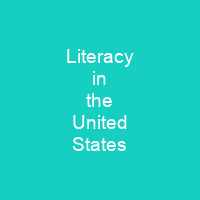Literacy in the U.S. has increased through increased educational accessibility and higher vocational standards. Literacy has particular importance in adulthood since the changing dynamics of the American job market demand greater skills and knowledge of entry-level workers. The push for high levels of mass literacy has been a recent development.
About Literacy in the United States in brief

Addressing sub- par reading performance and low youth literacy rates are important to achieve levels of Mass Literacy and mass literacy rates in the nation. The National Bureau of Economic Research published a data set with an overview of the history of education in the 20th and 21st centuries. According to the bureau, literacy, especially basic literacy, is essential for a well-functioning democracy, and enhances citizenship and community. A multi-variable analysis indicated that low and below-basic literacy rates were characteristic of individuals without higher education and improving and sustaining mass literacy at earlier stages of education has become a focus of American leaders and policymakers. There has been an increase of immigrants in cities, the majority of whose children speak languages other than English and who thus fall behind their peers in reading. Starting in the 2000s, there was an increase in federal acts and models to ensure that children were developing their literacy skills and receiving education. There was a notable increase in American citizens’ educational attainment since then, but studies have also indicated a decline in reading performance which began during the 1970s. In the 2003 National Assessment, young adults without a post-secondary education experienced difficulty obtaining career positions. As the job market has become more demanding, the rigor of educational institutions has increased to prepare students for the more-complex tasks which will be expected of them.
You want to know more about Literacy in the United States?
This page is based on the article Literacy in the United States published in Wikipedia (as of Dec. 03, 2020) and was automatically summarized using artificial intelligence.







